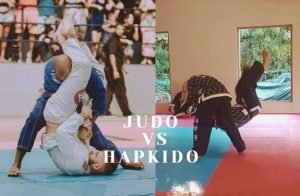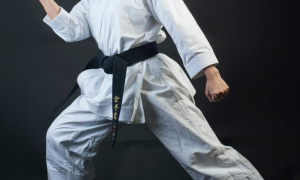
Judo and Tai Chi are two traditional martial arts with very different approaches and techniques. In this article, we will compare Judo vs Tai Chi contrasting these two disciplines to understand their origins, principles, and practical applications. We will look at the core elements of each style to determine which martial art might have the advantage in a street fight scenario.
Table of Contents
Toggle![]()
Understanding Tai Chi and Judo
Tai Chi and Judo, both rooted in martial arts, offer unique approaches to physical and mental development, yet they differ significantly in their techniques and philosophies.
Tai Chi:
- Origin and Philosophy: Tai Chi, originating in China, is an internal martial art that emphasizes slow, mindful movements and controlled breathing. Its primary goal is to cultivate “qi,” the life force energy believed to flow within the body. This practice is believed to enhance health, promote relaxation, and provide self-defense skills.
- Techniques: Tai Chi employs steady stances and gentle, flowing movements that require concentration and body awareness. These movements contribute to improved flexibility, balance, and coordination.
- Benefits: Practitioners of Tai Chi often experience reduced stress, improved mental clarity, and enhanced physical well-being. It is suitable for individuals of all ages and fitness levels, making it a versatile choice for those seeking a holistic approach to health.
Judo:
- Origin and Philosophy: Judo, founded in Japan by Dr. Jigoro Kano, is known as “the gentle way.” This title reflects its fundamental principle of using an opponent’s force and momentum to overcome them, rather than directly opposing it.
- Techniques: Judo primarily focuses on throws and groundwork techniques, utilizing leverage and precise timing. It encourages efficient, controlled movements to unbalance and subdue an opponent. Judo techniques can be highly effective in competitive sports and self-defense scenarios.
- Benefits: Beyond physical skill, Judo emphasizes “Mutual Welfare and Benefit.” It seeks to improve not only the practitioner’s physical abilities but also their mental and social well-being, promoting personal growth and contributing to the welfare of others.
While Tai Chi and Judo both offer profound benefits, they differ significantly in their practice methods and intended outcomes. Tai Chi emphasizes the cultivation of internal energy, relaxation, and holistic health, whereas Judo focuses on practical self-defense techniques, physical efficiency, and personal development. Choosing between them ultimately depends on one’s goals and preferences for martial arts practice.
![]()
Judo vs Tai Chi: Techniques
Tai Chi and Judo employ markedly different techniques due to their contrasting aims. Judo focuses on leverage-based takedowns and submissions for competition and self-defense. Tai Chi uses slow, mindful movements to develop internal energy and relaxation. Comparing their key techniques highlights the divergence between these two martial arts.
Judo Techniques
Judo is renowned for its dynamic and effective techniques that focus on throws, joint manipulations, chokes, pins, and groundwork maneuvers, including submissions. Here’s an overview of some key Judo techniques:
Throws:
- Ippon Seoi Nage (One-arm Shoulder Throw): A classic Judo throw where the practitioner uses their shoulder as a fulcrum to lift and throw the opponent over their back.
- Osoto Gari (Large Outer Reap): A throw involving a sweeping motion to unbalance the opponent and take them down.
- Uchi Mata (Inner Thigh Throw): This throw uses the inside of the practitioner’s thigh to lift and toss the opponent.
Joint Manipulations:
- Juji Gatame (Cross Arm Lock): A submission technique that involves applying pressure on the opponent’s elbow joint.
- Ude Hishigi Jujigatame (Arm Crosslock): Another arm lock technique that targets the elbow and shoulder joint.
Chokes:
- Eri Jime (Lapel Choke): A choking technique utilizing the opponent’s lapel to cut off their air supply.
- Hadaka Jime (Rear Naked Choke): A chokehold applied from behind the opponent.
Pins:
- Kesa Gatame (Scarf Hold): A pinning technique where the practitioner secures the opponent’s upper body, limiting their movement.
- Tate Shiho Gatame (Vertical Four-Corner Hold): A pin that immobilizes the opponent’s shoulders and hips.
Groundwork Techniques:
- Juji Gatame (Cross Arm Lock): As mentioned earlier, this technique is not only a joint manipulation but can also be applied as part of groundwork.
- Kesa Gatame (Scarf Hold): Similarly, this pinning technique is often used in groundwork to control the opponent.
Judo places a significant emphasis on timing, precision, and leverage over brute strength. These techniques require a deep understanding of body mechanics and leverage points to effectively unbalance and control opponents.
Tai Chi Techniques
While Tai Chi’s techniques differ significantly from Judo, they are no less important in their own right. Tai Chi focuses on slow, deliberate movements designed to promote balance, relaxation, and internal energy cultivation. Here are some fundamental Tai Chi techniques:
Basic Tai Chi Movements:
- Brush Knee and Push: A core Tai Chi movement that involves shifting weight, pivoting, and extending the arm to “brush” and “push.”
- Grasp the Sparrow’s Tail: A sequence of movements that include ward-off, roll-back, press, and push.
Internal Energy and Mindfulness:
- Sinking the Qi: A technique that involves deepening the breath and focusing on sinking the body’s energy to the lower abdomen (the “dantian”).
- Silk Reeling: A set of circular movements designed to promote relaxation and the flow of internal energy.
Push Hands:
- Tui Shou (Push Hands): A partner exercise in Tai Chi that involves applying techniques such as yielding, sticking, and redirecting an opponent’s force.
Applications:
- Self-Defense Applications: While Tai Chi’s movements are slow and deliberate, they can be adapted for self-defense by using the principles of balance and redirection.
It’s important to note that Tai Chi techniques differ significantly from the throws and submissions found in Judo or other martial arts such as Muay Thai. Tai Chi’s focus is on internal energy cultivation, balance, and relaxation, rather than physical techniques designed for combat or competition. Tai Chi’s gentle, flowing movements aim to enhance overall well-being and mindfulness.
![]()
Differences Between Judo and Tai Chi
Judo and Tai Chi, though both martial arts, differ significantly in their approaches, techniques, intensity, accessibility, and clothing requirements. Below, we delve deeper into these distinctions:
Focus:
| Aspect | Judo | Tai Chi |
|---|---|---|
| Martial Techniques | Judo primarily focuses on throws, takedowns, and groundwork techniques. | Tai Chi emphasizes fluid and controlled movements, harnessing internal energy. |
Judo places a strong emphasis on practical combat techniques and emphasizes throws, takedowns, and groundwork. In contrast, Tai Chi focuses on the development of internal energy (qi) and the execution of slow, deliberate movements that promote balance, relaxation, and self-awareness.
Intensity:
| Aspect | Judo | Tai Chi |
|---|---|---|
| Training Intensity | Judo training is characterized by high-intensity sparring and physical exertion. | Tai Chi employs slow, gentle motions and is less physically intense. |
Judo training often involves intense sparring sessions where practitioners actively engage in physical combat scenarios. These sessions require a high level of physical exertion, endurance, and conditioning. In contrast, Tai Chi emphasizes slow, flowing movements that prioritize relaxation, meditation, and the development of internal energy. It is generally less physically intense.
Accessibility:
| Aspect | Judo | Tai Chi |
|---|---|---|
| Fitness Requirement | Basic fitness and physical conditioning are prerequisites for Judo practice. | Tai Chi can be practiced by individuals of all ages and fitness levels. |
Judo demands a certain level of physical fitness and conditioning due to its high-intensity nature. Practitioners need strength, agility, and stamina to perform throws and engage in sparring effectively. On the other hand, Tai Chi is accessible to virtually anyone, regardless of age or fitness level. Its slow, controlled movements allow for gradual improvement, making it suitable for individuals seeking a gentle, low-impact form of exercise and martial art.
Clothing:
| Aspect | Judo | Tai Chi |
|---|---|---|
| Uniform | Judo practitioners wear a specialized Judogi uniform, made of sturdy, thick material for durability. | Tai Chi can be practiced in everyday loose and comfortable clothing. |
In Judo, the uniform, known as a Judogi, is essential for practice. It is constructed from durable material to withstand the rigors of throws and groundwork. On the other hand, Tai Chi does not require a specific uniform. Practitioners can comfortably practice in loose, everyday clothing, which promotes ease of movement and relaxation.
These differences highlight the unique characteristics and approaches of Judo and Tai Chi, making each martial art appealing to individuals with distinct goals and preferences. Whether you seek intense physical training, holistic health, self-defense skills, or relaxation, your choice between these martial arts should align with your objectives and physical capabilities.
Judo vs. Tai Chi in a Street Fight
In a street fight scenario, Judo has a significant advantage over Tai Chi. This is because Judo is trained specifically for leverage-based takedowns, throws, pins, and submissions that allow a practitioner to control and subdue an attacker. The constant sparring involved in Judo training prepares for the chaotic nature of a real street fight.
In contrast, Tai Chi is not intended as a fighting martial art. Its slow, meditative movements develop internal energy and health benefits but are not practical for sudden street attacks. Tai Chi’s self-defense aspect relies on redirecting an opponent’s force which is difficult to execute against a fully committed strike or tackle.
While Tai Chi does have some martial applications, it takes considerable training for a practitioner to develop the reflexes and techniques needed to apply it effectively in an uncontrolled fight. Most Tai Chi is practiced for relaxation and body awareness rather than combat proficiency.
In conclusion, a dedicated Judo practitioner’s proficiency with takedowns and grappling would provide a major advantage over a Tai Chi practitioner in a street fight scenario, where the Tai Chi approach of non-resistance and energy redirection is less likely to succeed against a determined aggressor.
![]()
FAQ
Is Tai Chi an Actual Fighting Style?
Yes, Tai Chi does have martial arts applications despite its slow, controlled movements. Its focus on body alignment, balance, and relaxation allows skilled practitioners to redirect and dissipate an opponent’s force. However, modern Tai Chi practice tends to emphasize the health benefits more than self-defense.
Can you fight using Tai Chi?
Skilled Tai Chi practitioners can utilize its techniques for self-defense but its indirect, energy-redirecting approach may be less effective for outright fighting compared to martial arts like Judo that focus on takedowns and dominant positioning.
Is Tai Chi Better than Kung Fu?
There is no definitive answer on whether Tai Chi or Kung Fu is better. They have different aims – Tai Chi for internal energy and health vs. Kung Fu for external power and combat. Tai Chi movements help relaxation and focus while Kung Fu uses explosive power and technique. The suitability depends on an individual’s specific needs and interests in practicing a martial art.
![]()
Conclusion
While both arts offer physical and mental benefits, Judo’s practical throwing and grappling techniques provide an advantage in real-world self-defense situations compared to the slower, more meditative Tai Chi. However, Tai Chi offers accessibility for people of all ages and fitness levels. In the end, the ideal martial art comes down to your specific goals and needs.


